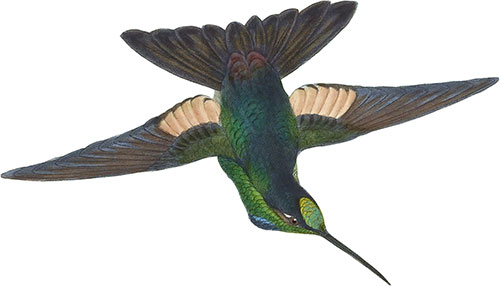The members of the genus Helianthea, distinguished by their star-like frontlets and luminous under-surfaces, appear to range next to the preceding. Three of them (namely, H. typica, H. Bonapartei, and H. Eos) are quite typical; but the H. Lutetiæ and H. violifera differ somewhat in their colouring, the lower part of the body of the two latter species not being luminous, while they assimilate in all other respects. Dr. Reichenbach’s separation of the H. typica and H. Bonapartei into a separate genus (Hypochrysa) cannot, in my opinion, for a moment be admitted.
Generic characters.
Male.—Bill long, straight and cylindrical; wings moderately long and powerful; tail of medium size and slightly forked when closed; tarsi extremely short and clothed with feathers; feet very small; hind toe the shortest; forehead and under-surface luminous.
Female.—Destitute of luminous colouring.
The members of this genus frequent the Andes for at least eight degrees on each side of the equator.
Helianthea typica
Habitat: New Granada. Is exceedingly common in the neighbourhood of Bogota. A large race occurs near Pamplona.
 Plate 235
Helianthea typica
Star-frontlet
Plate 235
Helianthea typica
Star-frontlet
Helianthea Bonapartei
Habitat: New Granada. Examples frequently occur in collections from Bogota.
 Plate 236
Helianthea Bonapartei
Bonaparte’s Star-frontlet
Plate 236
Helianthea Bonapartei
Bonaparte’s Star-frontlet
Helianthea Eos (Gould)
Habitat: Paramos da los Conejos, near Merida in Columbia
 Plate 237
Helianthea Eos
Golden Star-frontlet
Plate 237
Helianthea Eos
Golden Star-frontlet
Helianthea Lutetiæ
Habitat: Popayan and Ecuador. Professor Jameson and Mr. Fraser state that “This bird is found in the valleys of Lloa and Pelogalli, but not nearer Quito.” —Ibis, vol. i. p. 400.
 Plate 238
Helianthea Lutetiæ
Comte de Paris
Plate 238
Helianthea Lutetiæ
Comte de Paris
Helianthea violifera (Gould)
Habitat: “In proving Chulimani au Cordilera” in Bolivia (Warszewicz).
 Plate 239
Helianthea violifera
Violet-throated Star-frontlet
Plate 239
Helianthea violifera
Violet-throated Star-frontlet
Featuring all 422 illustrated species from John Gould’s A Monograph of the Trochilidæ, or Family of Humming-Birds arranged by color.